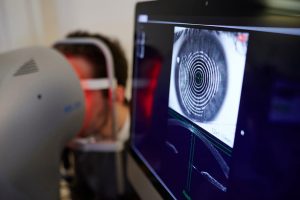Your Eyes: Separating the Facts and the Fiction

The complexity of our eyes makes them one of the wonders of the evolutionary world. But it is also the source of many myths. Moreover, the World Health Organisation states that at least half of the cases of visual impairment worldwide are preventable. Many of us think we have a pretty good idea about what is good and bad for our eyes, but what’s the truth behind it all?
In this article, we explore some of the most popular eye-related claims – and separate the fact from the fiction.
1. “Sitting too close to the TV will make you short-sighted”
False – There is no evidence to suggest that sitting close to the TV will increase your risk of developing myopia (short-sightedness). However, extended screen time can increase your risk of headaches, fatigue, and dry eyes. Furthermore, some evidence suggests that myopia is more common in people living in urban areas, with fewer open spaces.
2. “Wearing your glasses all the time will make your vision worse”
False – Glasses can be an annoyance in many parts of our lives; however, assuming that your current prescription is correct, wearing your glasses will not cause your vision to worsen. Nonetheless, it is important to note that your prescription may change over time. This can be due to ageing, disease, or fluctuations in hormones. It is therefore important to have regular eye tests.
3. “Looking directly at the sun can make you go blind”
True – The sun’s light is not only the source of our vision, but it can also be incredibly dangerous for our eyes. Looking directly at the sun can cause headaches and temporary vision problems, but it can also cause permanent damage. The cumulative effects of ultraviolet (UV) radiation have been linked to conditions like macular degeneration, solar retinitis and corneal dystrophies.
So it’s always best to avoid looking at the sun, even when it seems to be hiding! It is also important to wear sunglasses with maximum UV protection on sunny (and even no-so-sunny) days.
4. “There is nothing you can do to prevent loss of vision”
True and False – While some loss of vision can be a part of the eye’s natural ageing process, there are some things you can do to maintain your vision for as long as possible. For example, keeping your eyes clean and free from infection, and eating a healthy balanced diet. Moreover, not all vision loss is age-related, and many eye conditions can be effectively prevented and treated.
See an optician as soon as you notice any changes in your eyes. This can help them to diagnose any diseases early, potentially preventing any future vision loss.
5. “Carrots can help you see in the dark”
True – While this may be something our parents used to say to get us to eat our vegetables, it is actually rooted in fact. Carrots contain high levels of beta-carotene which is converted to Vitamin A in the body. This can help to protect against age-related macular degeneration and reduce the risk of developing cataracts!
Beta-carotene is also the main proponent in the development of retinol, an essential chemical for vision in dim light. So, while they may not be as effective as night vision goggles, carrots certainly can help you see better in the dark.
6. “Eyes are full size at birth”
False – While babies’ eyes do look wondrously large, they wouldn’t be quite as cute if their eyes were indeed full size from birth. Rather, a baby’s eyes are proportionate to the rest of their bodies and will grow over time. In fact, eye growth can account for vision improvement as children develop.
7. “It is possible to have an eye transplant”
False – While our transplantation abilities are becoming more advanced all the time, it is still not possible to have a whole eye transplant. However, transplants are possible for certain parts of the eye, such as the cornea. Nonetheless, any Minority Report-style identity changes are out of the question – for now, at least.
8. “If you have bad eyes, your kids will too”
True – Unfortunately, many aspects of our vision can be genetic, meaning your children are likely to inherit any eye-related problems you might have. More than 350 eye diseases have been linked to genetics, including long-sightedness, short-sightedness, colour blindness, and lazy eye.
9. “Only boys are colour-blind”
False – Colour blindness is usually caused by changes to the genetic code sequencing which result in ‘faulty’ electrical signals being sent to the brain. But while it is often said that only boys are colour-blind, this isn’t actually the case – although it is more common in males.
The gene which is responsible for red/green colour blindness is carried on the X chromosome, which explains why colour blindness is more common in males than females. Around 8% of boys suffer from the condition, compared to just 1% of girls.
10. “Two brown-eyed parents can’t have a blue-eyed child and vice versa”
False – You may recall the lesson on dominant and recessive genes from secondary school biology lessons. And eye colour was likely used as an example to explain how they work. The gene for brown eyes is a dominant gene while the blue eye gene is recessive. This means that in most cases, the child of two brown-eyed parents will also have brown eyes – but this isn’t always the case.
Without getting too scientific, there is generally a 25% that two brown-eyed parents will have a blue-eyed child as they both carry a recessive blue-eye gene that can be passed to the next generation!
So there you have it, 10 common eye “facts”, either confirmed or busted! If you would like to learn more about treatments for common eye conditions, get in touch with one of our friendly clinic coordinators, or Book a Consultation today.


